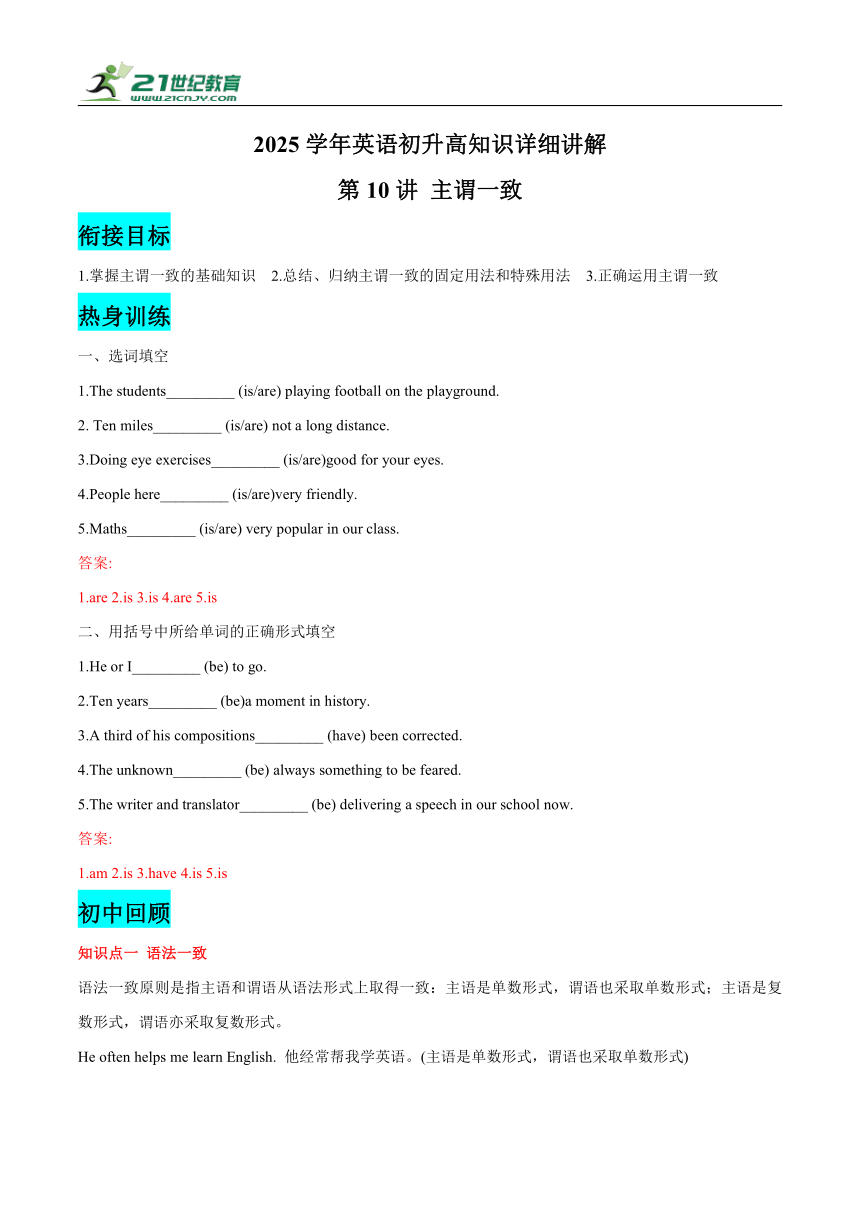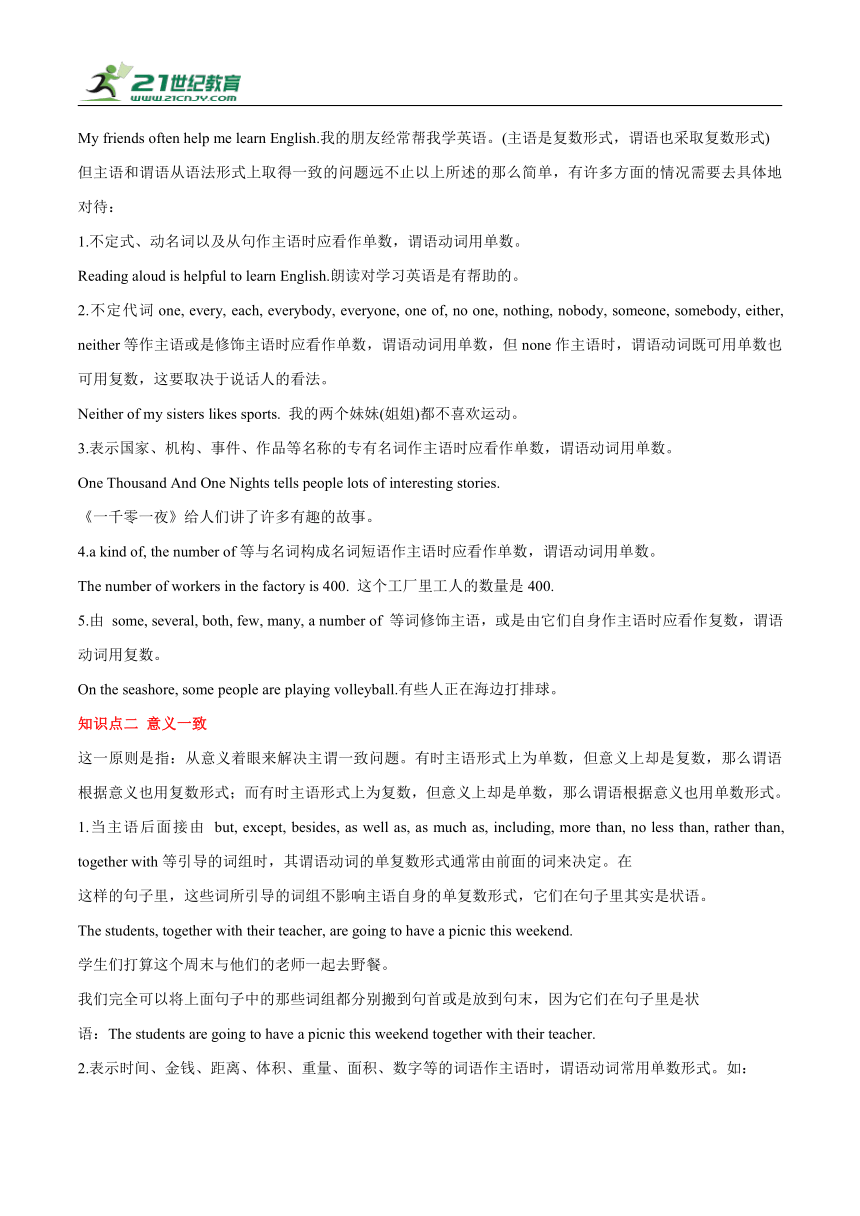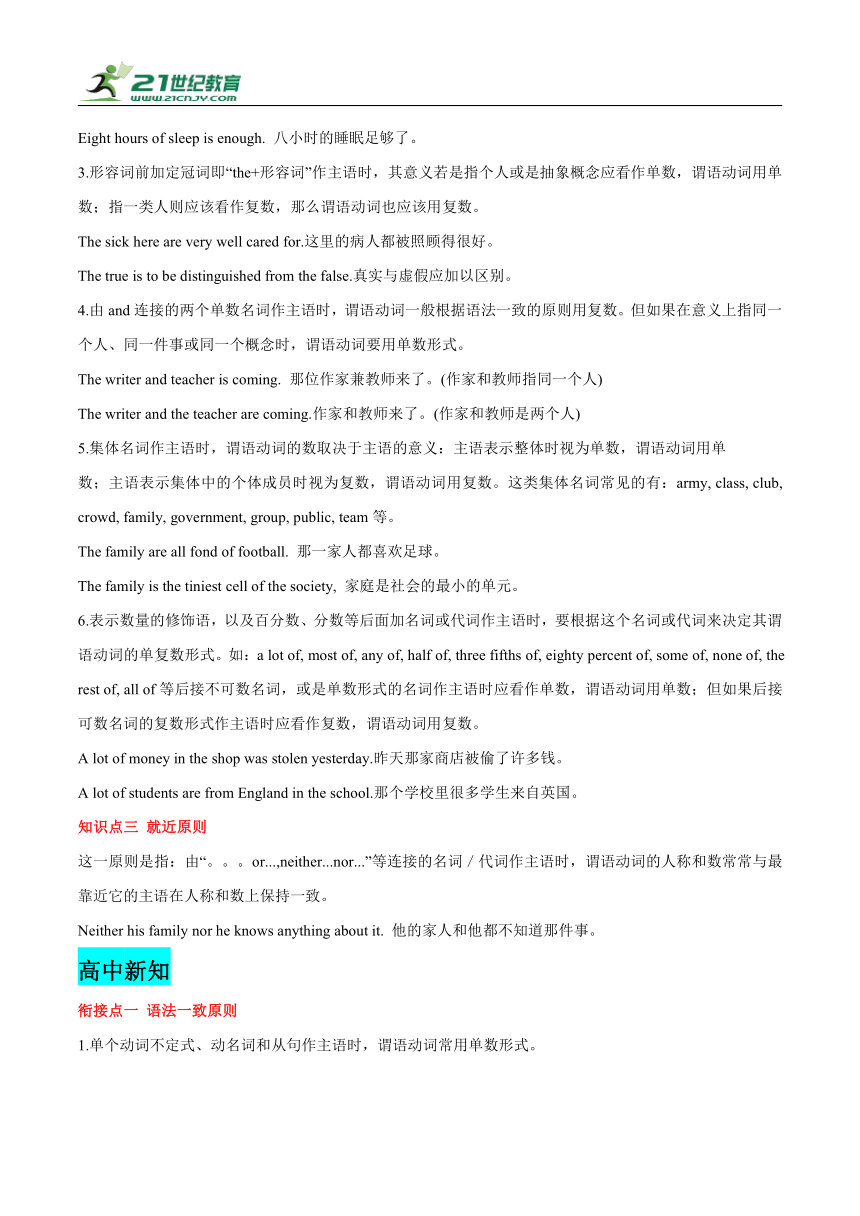第10讲 主谓一致-2025学年英语初升高知识详细讲解
文档属性
| 名称 | 第10讲 主谓一致-2025学年英语初升高知识详细讲解 |  | |
| 格式 | docx | ||
| 文件大小 | 63.9KB | ||
| 资源类型 | 试卷 | ||
| 版本资源 | 人教新目标(Go for it)版 | ||
| 科目 | 英语 | ||
| 更新时间 | 2025-06-20 00:35:09 | ||
图片预览



文档简介
2025学年英语初升高知识详细讲解
第10讲 主谓一致
衔接目标
1.掌握主谓一致的基础知识 2.总结、归纳主谓一致的固定用法和特殊用法 3.正确运用主谓一致
热身训练
一、选词填空
1.The students_________ (is/are) playing football on the playground.
2. Ten miles_________ (is/are) not a long distance.
3.Doing eye exercises_________ (is/are)good for your eyes.
4.People here_________ (is/are)very friendly.
5.Maths_________ (is/are) very popular in our class.
答案:
1.are 2.is 3.is 4.are 5.is
二、用括号中所给单词的正确形式填空
1.He or I_________ (be) to go.
2.Ten years_________ (be)a moment in history.
3.A third of his compositions_________ (have) been corrected.
4.The unknown_________ (be) always something to be feared.
5.The writer and translator_________ (be) delivering a speech in our school now.
答案:
1.am 2.is 3.have 4.is 5.is
初中回顾
知识点一 语法一致
语法一致原则是指主语和谓语从语法形式上取得一致:主语是单数形式,谓语也采取单数形式;主语是复数形式,谓语亦采取复数形式。
He often helps me learn English. 他经常帮我学英语。(主语是单数形式,谓语也采取单数形式)
My friends often help me learn English.我的朋友经常帮我学英语。(主语是复数形式,谓语也采取复数形式)
但主语和谓语从语法形式上取得一致的问题远不止以上所述的那么简单,有许多方面的情况需要去具体地对待:
1.不定式、动名词以及从句作主语时应看作单数,谓语动词用单数。
Reading aloud is helpful to learn English.朗读对学习英语是有帮助的。
2.不定代词one, every, each, everybody, everyone, one of, no one, nothing, nobody, someone, somebody, either, neither等作主语或是修饰主语时应看作单数,谓语动词用单数,但none作主语时,谓语动词既可用单数也可用复数,这要取决于说话人的看法。
Neither of my sisters likes sports. 我的两个妹妹(姐姐)都不喜欢运动。
3.表示国家、机构、事件、作品等名称的专有名词作主语时应看作单数,谓语动词用单数。
One Thousand And One Nights tells people lots of interesting stories.
《一千零一夜》给人们讲了许多有趣的故事。
4.a kind of, the number of等与名词构成名词短语作主语时应看作单数,谓语动词用单数。
The number of workers in the factory is 400. 这个工厂里工人的数量是400.
5.由 some, several, both, few, many, a number of 等词修饰主语,或是由它们自身作主语时应看作复数,谓语动词用复数。
On the seashore, some people are playing volleyball.有些人正在海边打排球。
知识点二 意义一致
这一原则是指:从意义着眼来解决主谓一致问题。有时主语形式上为单数,但意义上却是复数,那么谓语根据意义也用复数形式;而有时主语形式上为复数,但意义上却是单数,那么谓语根据意义也用单数形式。
1.当主语后面接由 but, except, besides, as well as, as much as, including, more than, no less than, rather than, together with等引导的词组时,其谓语动词的单复数形式通常由前面的词来决定。在
这样的句子里,这些词所引导的词组不影响主语自身的单复数形式,它们在句子里其实是状语。
The students, together with their teacher, are going to have a picnic this weekend.
学生们打算这个周末与他们的老师一起去野餐。
我们完全可以将上面句子中的那些词组都分别搬到句首或是放到句末,因为它们在句子里是状
语:The students are going to have a picnic this weekend together with their teacher.
2.表示时间、金钱、距离、体积、重量、面积、数字等的词语作主语时,谓语动词常用单数形式。如:
Eight hours of sleep is enough. 八小时的睡眠足够了。
3.形容词前加定冠词即“the+形容词”作主语时,其意义若是指个人或是抽象概念应看作单数,谓语动词用单数;指一类人则应该看作复数,那么谓语动词也应该用复数。
The sick here are very well cared for.这里的病人都被照顾得很好。
The true is to be distinguished from the false.真实与虚假应加以区别。
4.由and连接的两个单数名词作主语时,谓语动词一般根据语法一致的原则用复数。但如果在意义上指同一个人、同一件事或同一个概念时,谓语动词要用单数形式。
The writer and teacher is coming. 那位作家兼教师来了。(作家和教师指同一个人)
The writer and the teacher are coming.作家和教师来了。(作家和教师是两个人)
5.集体名词作主语时,谓语动词的数取决于主语的意义:主语表示整体时视为单数,谓语动词用单
数;主语表示集体中的个体成员时视为复数,谓语动词用复数。这类集体名词常见的有:army, class, club, crowd, family, government, group, public, team等。
The family are all fond of football. 那一家人都喜欢足球。
The family is the tiniest cell of the society, 家庭是社会的最小的单元。
6.表示数量的修饰语,以及百分数、分数等后面加名词或代词作主语时,要根据这个名词或代词来决定其谓语动词的单复数形式。如:a lot of, most of, any of, half of, three fifths of, eighty percent of, some of, none of, the rest of, all of等后接不可数名词,或是单数形式的名词作主语时应看作单数,谓语动词用单数;但如果后接可数名词的复数形式作主语时应看作复数,谓语动词用复数。
A lot of money in the shop was stolen yesterday.昨天那家商店被偷了许多钱。
A lot of students are from England in the school.那个学校里很多学生来自英国。
知识点三 就近原则
这一原则是指:由“。。。or...,neither...nor...”等连接的名词/代词作主语时,谓语动词的人称和数常常与最靠近它的主语在人称和数上保持一致。
Neither his family nor he knows anything about it. 他的家人和他都不知道那件事。
高中新知
衔接点一 语法一致原则
1.单个动词不定式、动名词和从句作主语时,谓语动词常用单数形式。
2.“A+as well as/rather than/but/except/besides/with/along with/together with/like/including/ in addition to/combined with+ B”作主语时,因B不算主语成分,故谓语动词形式与A保持一致。
The girl together with some boys has gone to plant trees. 那个女孩和一些男孩一起去植树了。
3.A and B作主语时,谓语动词通常用复数。但下列情况除外:
(1)“every/each/no+单数名词+and+every/each/no+单数名词”作主语时,谓语动词常用单数;
(2)A and B表示同一个人、物或同一个概念时,谓语动词用单数。
The author and professor is delivering a lecture to us. 那位作家兼教授正在给我们做演讲。
4.“many a/more than one+单数名词”和“one and a half+复数名词”作主语时,谓语动词仍用单数形式。
More than one man has been fired. 不止一人被解雇了。
5.常用复数形式的名词:trousers(裤子),clothes(衣服),glasses(眼镜),chopsticks(筷子),scissors (剪刀),compasses(圆规),gloves(手套)等作主语时,谓语动词用复数。但当主语被kind of/type of/pair of/amount of等修饰时,谓语动词的形式须根据kind/type/pair/amount等的数来确定。
衔接点二 意义一致原则
1.分数、百分数,all, some, the rest, half of, most of, part of等作主语或修饰主语时,谓语动词的单复数根据其修饰的名词来确定。
Most of the workers have gone home for a holiday.大部分工人回家度假了。
2.主语为集体名词时
cattle, people, police, public作主语时,谓语动词常常用复数形式;集体名词army, audience, class, club, committee, crowd, family, majority, minority, staff, team作主语时,如果表示一个整体,谓语动词用单数;如果指其中的个体,谓语动词用复数。
My family is a big one. 我家是个大家庭。
His family were sitting on the sofa watching TV when I got there.当我到那儿时,他的家人正坐在沙发上看电视。
3.such作主语时,谓语动词的单复数形式要根据其意义而定。
Such are the books we need. 这些是我们需要的书。
4.a number of+复数名词,意为“许多·····.”,通常表复数意义;the number of+复数名词,意为“·.···的数目”,通常表单数意义。“a quantity/amount of+名词”作主语时,谓语动词多用单数形式;“quantities/amounts of+名词”作主语时,谓语动词多用复数形式。
The number of students present at the sports meeting is 1,800.出席运动会的学生人数是1800人。
5.以-s结尾但意义为单数的名词(词组)作主语
(1)表示时间、距离、金额、重量、空间、体积等意义的复数名词作主语时通常作整体来看,谓语动词用单数形式。
(2)news, plastics等形式上是复数而意义上是单数的名词以及physics, mechanics, politics等以-ics结尾的学科名词作主语时,谓语动词用单数形式。
News is travelling fast nowadays. 如今,消息传播得很快。
(3)国名、人名、报纸名、书名等专有名词,形式上是复数,但它们作主语时谓语动词常用单数。
The United Nations was founded in 1945. 联合国成立于1945年。
6.单复数同形的名词sheep, means, goods, deer, fish, series, works等作主语时,要根据具体情况来确定谓语动词的数。
Every means has been tried, but none proved successful.每个办法都尝试过了,但没有一个是成功的。
Many means are of no effect.许多方法都没效果。
衔接点三 就近一致原则
1.there be句型中be动词的形式由它后面的第一个名词的数决定。
There are some envelopes and paper for you. 有一些信封和纸张给你。
2.由“..or..., either...or..., neither...nor..., not only...but (also)..., not...but...”等连接的名词/代词作主语时,谓语动词常与最靠近它们的主语在人称和数上保持一致。
Neither the children nor the mother knows anything about it.孩子们和母亲都不知道这件事。
巩固训练
一、用括号中所给单词的正确形式填空
1.Even as it is, great damage_________ (do).
2. The police with some police dogs_________ (search) for the thief from 7 p.m. to 9 p.m. yesterday.
3.Not only Peter but also I_________ (offer) a well-paid job last month because of our hard work.
4.A student or two_________ (fail)the exam.
5.One and a half hours_________ (be)enough.
答案:
1.has been done 2.were searching 3. was offered 4.has failed 5.is
二、语法填空
My husband looked surprised when he saw tears 1. _________ (flow) down my face. We had just watched a movie with a sad ending which was out of character for me and I couldn't stop 2. _________ (cry).But I wasn't crying for 3. _________ couple in the film. I was crying for the many deep hurts I have seen in people 4. _________ I love very much. And there was nothing I could do 5. _________ (cure)those hurts.
The movie brought back memories of when I 6. _________ (fill) with deep hurts-some were real; some weren't. I did not know how to control 7. _________ (disappoint).
My husband and I 8. _________ (be)active in the youth group, children's groups, singing in the class, etc. We had four 9. _________ (health) children, a new home and were financially(经济上地) stable(稳定的).And I was satisfied,10. _________ I knew I was living a good life and I would have a better life.
答案:
1.flowing 2.crying 3.the 4.who/whom 5,to cure
6.was filled 7. disappointment(s) 8.were 9.healthy 10.because
三、完成句子
1.我们关心的全部问题就是富人是否缴纳了自己应付的那部分税。
___________________________ are paying their share.
2.近25%的受访者称他们的父母居住在另一个城市,他们只能不定期回去看望父母。
Nearly 25 percent of respondents___________________________ and can only visit them irregularly.
3.许多名人都被邀请参加这个聚会。
A number of famous people___________________________ the party.
4.对于我们大多数人来说,学习不做我们习惯做的事情需要很大的努力。
For most of us, learning not to do the things we're used to___________________________.
5.无论是老师还是学生都是我们的朋友。
Either the teacher or the students___________________________.
答案:
1.All we care about is whether the rich
2.say their patents live in another city
3. were/are invited to 4. requires great effort 5.are our friends
第10讲 主谓一致
衔接目标
1.掌握主谓一致的基础知识 2.总结、归纳主谓一致的固定用法和特殊用法 3.正确运用主谓一致
热身训练
一、选词填空
1.The students_________ (is/are) playing football on the playground.
2. Ten miles_________ (is/are) not a long distance.
3.Doing eye exercises_________ (is/are)good for your eyes.
4.People here_________ (is/are)very friendly.
5.Maths_________ (is/are) very popular in our class.
答案:
1.are 2.is 3.is 4.are 5.is
二、用括号中所给单词的正确形式填空
1.He or I_________ (be) to go.
2.Ten years_________ (be)a moment in history.
3.A third of his compositions_________ (have) been corrected.
4.The unknown_________ (be) always something to be feared.
5.The writer and translator_________ (be) delivering a speech in our school now.
答案:
1.am 2.is 3.have 4.is 5.is
初中回顾
知识点一 语法一致
语法一致原则是指主语和谓语从语法形式上取得一致:主语是单数形式,谓语也采取单数形式;主语是复数形式,谓语亦采取复数形式。
He often helps me learn English. 他经常帮我学英语。(主语是单数形式,谓语也采取单数形式)
My friends often help me learn English.我的朋友经常帮我学英语。(主语是复数形式,谓语也采取复数形式)
但主语和谓语从语法形式上取得一致的问题远不止以上所述的那么简单,有许多方面的情况需要去具体地对待:
1.不定式、动名词以及从句作主语时应看作单数,谓语动词用单数。
Reading aloud is helpful to learn English.朗读对学习英语是有帮助的。
2.不定代词one, every, each, everybody, everyone, one of, no one, nothing, nobody, someone, somebody, either, neither等作主语或是修饰主语时应看作单数,谓语动词用单数,但none作主语时,谓语动词既可用单数也可用复数,这要取决于说话人的看法。
Neither of my sisters likes sports. 我的两个妹妹(姐姐)都不喜欢运动。
3.表示国家、机构、事件、作品等名称的专有名词作主语时应看作单数,谓语动词用单数。
One Thousand And One Nights tells people lots of interesting stories.
《一千零一夜》给人们讲了许多有趣的故事。
4.a kind of, the number of等与名词构成名词短语作主语时应看作单数,谓语动词用单数。
The number of workers in the factory is 400. 这个工厂里工人的数量是400.
5.由 some, several, both, few, many, a number of 等词修饰主语,或是由它们自身作主语时应看作复数,谓语动词用复数。
On the seashore, some people are playing volleyball.有些人正在海边打排球。
知识点二 意义一致
这一原则是指:从意义着眼来解决主谓一致问题。有时主语形式上为单数,但意义上却是复数,那么谓语根据意义也用复数形式;而有时主语形式上为复数,但意义上却是单数,那么谓语根据意义也用单数形式。
1.当主语后面接由 but, except, besides, as well as, as much as, including, more than, no less than, rather than, together with等引导的词组时,其谓语动词的单复数形式通常由前面的词来决定。在
这样的句子里,这些词所引导的词组不影响主语自身的单复数形式,它们在句子里其实是状语。
The students, together with their teacher, are going to have a picnic this weekend.
学生们打算这个周末与他们的老师一起去野餐。
我们完全可以将上面句子中的那些词组都分别搬到句首或是放到句末,因为它们在句子里是状
语:The students are going to have a picnic this weekend together with their teacher.
2.表示时间、金钱、距离、体积、重量、面积、数字等的词语作主语时,谓语动词常用单数形式。如:
Eight hours of sleep is enough. 八小时的睡眠足够了。
3.形容词前加定冠词即“the+形容词”作主语时,其意义若是指个人或是抽象概念应看作单数,谓语动词用单数;指一类人则应该看作复数,那么谓语动词也应该用复数。
The sick here are very well cared for.这里的病人都被照顾得很好。
The true is to be distinguished from the false.真实与虚假应加以区别。
4.由and连接的两个单数名词作主语时,谓语动词一般根据语法一致的原则用复数。但如果在意义上指同一个人、同一件事或同一个概念时,谓语动词要用单数形式。
The writer and teacher is coming. 那位作家兼教师来了。(作家和教师指同一个人)
The writer and the teacher are coming.作家和教师来了。(作家和教师是两个人)
5.集体名词作主语时,谓语动词的数取决于主语的意义:主语表示整体时视为单数,谓语动词用单
数;主语表示集体中的个体成员时视为复数,谓语动词用复数。这类集体名词常见的有:army, class, club, crowd, family, government, group, public, team等。
The family are all fond of football. 那一家人都喜欢足球。
The family is the tiniest cell of the society, 家庭是社会的最小的单元。
6.表示数量的修饰语,以及百分数、分数等后面加名词或代词作主语时,要根据这个名词或代词来决定其谓语动词的单复数形式。如:a lot of, most of, any of, half of, three fifths of, eighty percent of, some of, none of, the rest of, all of等后接不可数名词,或是单数形式的名词作主语时应看作单数,谓语动词用单数;但如果后接可数名词的复数形式作主语时应看作复数,谓语动词用复数。
A lot of money in the shop was stolen yesterday.昨天那家商店被偷了许多钱。
A lot of students are from England in the school.那个学校里很多学生来自英国。
知识点三 就近原则
这一原则是指:由“。。。or...,neither...nor...”等连接的名词/代词作主语时,谓语动词的人称和数常常与最靠近它的主语在人称和数上保持一致。
Neither his family nor he knows anything about it. 他的家人和他都不知道那件事。
高中新知
衔接点一 语法一致原则
1.单个动词不定式、动名词和从句作主语时,谓语动词常用单数形式。
2.“A+as well as/rather than/but/except/besides/with/along with/together with/like/including/ in addition to/combined with+ B”作主语时,因B不算主语成分,故谓语动词形式与A保持一致。
The girl together with some boys has gone to plant trees. 那个女孩和一些男孩一起去植树了。
3.A and B作主语时,谓语动词通常用复数。但下列情况除外:
(1)“every/each/no+单数名词+and+every/each/no+单数名词”作主语时,谓语动词常用单数;
(2)A and B表示同一个人、物或同一个概念时,谓语动词用单数。
The author and professor is delivering a lecture to us. 那位作家兼教授正在给我们做演讲。
4.“many a/more than one+单数名词”和“one and a half+复数名词”作主语时,谓语动词仍用单数形式。
More than one man has been fired. 不止一人被解雇了。
5.常用复数形式的名词:trousers(裤子),clothes(衣服),glasses(眼镜),chopsticks(筷子),scissors (剪刀),compasses(圆规),gloves(手套)等作主语时,谓语动词用复数。但当主语被kind of/type of/pair of/amount of等修饰时,谓语动词的形式须根据kind/type/pair/amount等的数来确定。
衔接点二 意义一致原则
1.分数、百分数,all, some, the rest, half of, most of, part of等作主语或修饰主语时,谓语动词的单复数根据其修饰的名词来确定。
Most of the workers have gone home for a holiday.大部分工人回家度假了。
2.主语为集体名词时
cattle, people, police, public作主语时,谓语动词常常用复数形式;集体名词army, audience, class, club, committee, crowd, family, majority, minority, staff, team作主语时,如果表示一个整体,谓语动词用单数;如果指其中的个体,谓语动词用复数。
My family is a big one. 我家是个大家庭。
His family were sitting on the sofa watching TV when I got there.当我到那儿时,他的家人正坐在沙发上看电视。
3.such作主语时,谓语动词的单复数形式要根据其意义而定。
Such are the books we need. 这些是我们需要的书。
4.a number of+复数名词,意为“许多·····.”,通常表复数意义;the number of+复数名词,意为“·.···的数目”,通常表单数意义。“a quantity/amount of+名词”作主语时,谓语动词多用单数形式;“quantities/amounts of+名词”作主语时,谓语动词多用复数形式。
The number of students present at the sports meeting is 1,800.出席运动会的学生人数是1800人。
5.以-s结尾但意义为单数的名词(词组)作主语
(1)表示时间、距离、金额、重量、空间、体积等意义的复数名词作主语时通常作整体来看,谓语动词用单数形式。
(2)news, plastics等形式上是复数而意义上是单数的名词以及physics, mechanics, politics等以-ics结尾的学科名词作主语时,谓语动词用单数形式。
News is travelling fast nowadays. 如今,消息传播得很快。
(3)国名、人名、报纸名、书名等专有名词,形式上是复数,但它们作主语时谓语动词常用单数。
The United Nations was founded in 1945. 联合国成立于1945年。
6.单复数同形的名词sheep, means, goods, deer, fish, series, works等作主语时,要根据具体情况来确定谓语动词的数。
Every means has been tried, but none proved successful.每个办法都尝试过了,但没有一个是成功的。
Many means are of no effect.许多方法都没效果。
衔接点三 就近一致原则
1.there be句型中be动词的形式由它后面的第一个名词的数决定。
There are some envelopes and paper for you. 有一些信封和纸张给你。
2.由“..or..., either...or..., neither...nor..., not only...but (also)..., not...but...”等连接的名词/代词作主语时,谓语动词常与最靠近它们的主语在人称和数上保持一致。
Neither the children nor the mother knows anything about it.孩子们和母亲都不知道这件事。
巩固训练
一、用括号中所给单词的正确形式填空
1.Even as it is, great damage_________ (do).
2. The police with some police dogs_________ (search) for the thief from 7 p.m. to 9 p.m. yesterday.
3.Not only Peter but also I_________ (offer) a well-paid job last month because of our hard work.
4.A student or two_________ (fail)the exam.
5.One and a half hours_________ (be)enough.
答案:
1.has been done 2.were searching 3. was offered 4.has failed 5.is
二、语法填空
My husband looked surprised when he saw tears 1. _________ (flow) down my face. We had just watched a movie with a sad ending which was out of character for me and I couldn't stop 2. _________ (cry).But I wasn't crying for 3. _________ couple in the film. I was crying for the many deep hurts I have seen in people 4. _________ I love very much. And there was nothing I could do 5. _________ (cure)those hurts.
The movie brought back memories of when I 6. _________ (fill) with deep hurts-some were real; some weren't. I did not know how to control 7. _________ (disappoint).
My husband and I 8. _________ (be)active in the youth group, children's groups, singing in the class, etc. We had four 9. _________ (health) children, a new home and were financially(经济上地) stable(稳定的).And I was satisfied,10. _________ I knew I was living a good life and I would have a better life.
答案:
1.flowing 2.crying 3.the 4.who/whom 5,to cure
6.was filled 7. disappointment(s) 8.were 9.healthy 10.because
三、完成句子
1.我们关心的全部问题就是富人是否缴纳了自己应付的那部分税。
___________________________ are paying their share.
2.近25%的受访者称他们的父母居住在另一个城市,他们只能不定期回去看望父母。
Nearly 25 percent of respondents___________________________ and can only visit them irregularly.
3.许多名人都被邀请参加这个聚会。
A number of famous people___________________________ the party.
4.对于我们大多数人来说,学习不做我们习惯做的事情需要很大的努力。
For most of us, learning not to do the things we're used to___________________________.
5.无论是老师还是学生都是我们的朋友。
Either the teacher or the students___________________________.
答案:
1.All we care about is whether the rich
2.say their patents live in another city
3. were/are invited to 4. requires great effort 5.are our friends
同课章节目录
